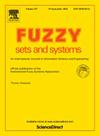模糊计算树逻辑的增量模型检查
IF 3.2
1区 数学
Q2 COMPUTER SCIENCE, THEORY & METHODS
引用次数: 0
摘要
模糊模型检查,又称多值模型检查,已被证明是验证模糊系统属性的有效技术。模糊模型检查的一个重要问题是,模糊模型检查所采用的模型经常会随着微小的变化而更新,而每次更新都要从头开始运行模型检查算法的成本太高。为了解决这个问题,我们在本文中考虑了模糊系统的增量模型检查方法,即最大限度地利用以前的模型检查结果,或者换句话说,尽量减少不必要的重新计算。我们研究的模型是模糊克里普克结构,它是克里普克结构的模糊对应物,用于描述模糊系统,而模糊系统的属性则用模糊计算树逻辑来表达,这是一种从计算树逻辑衍生出来的模糊时间逻辑。本文的重点是如何为两个until-form公式设计增量模型检查算法,这两个until-form公式表征了模糊克里普克结构在过渡插入或删除(而不是两者)情况下的最大或双最小约束可达性属性。我们以移动机器人的路径规划问题为例,说明了这种方法的可行性。本文章由计算机程序翻译,如有差异,请以英文原文为准。
Incremental model checking for fuzzy computation tree logic
Fuzzy model checking, also called multi-valued model checking, has proved to be an effective technique in verifying properties of fuzzy systems. One important issue with fuzzy model checking, is that a model adopted in fuzzy model checking is frequently updated with small changes, and it is too costly to run a model-checking algorithm from scratch in response to every update. To address the issue, in this paper, we consider the incremental model-checking approach for fuzzy systems by making maximal use of previous model checking results or in other words, by minimizing unnecessary recomputation. The models of our study are fuzzy Kripke structures, which are a fuzzy counterpart of Kripke structures and used to describe fuzzy systems, while the properties of fuzzy systems are expressed using fuzzy computation tree logic, a fuzzy temporal logic derived from computation tree logic. The focus of the paper is on how to design incremental model-checking algorithms for two until-formulas which characterize the maximal or dually minimum constrained reachability properties with respect to fuzzy Kripke structures under transition insertions or deletions but not both. The feasibility of our approach is illustrated by an example arising from the path planning problem of mobile robots.
求助全文
通过发布文献求助,成功后即可免费获取论文全文。
去求助
来源期刊

Fuzzy Sets and Systems
数学-计算机:理论方法
CiteScore
6.50
自引率
17.90%
发文量
321
审稿时长
6.1 months
期刊介绍:
Since its launching in 1978, the journal Fuzzy Sets and Systems has been devoted to the international advancement of the theory and application of fuzzy sets and systems. The theory of fuzzy sets now encompasses a well organized corpus of basic notions including (and not restricted to) aggregation operations, a generalized theory of relations, specific measures of information content, a calculus of fuzzy numbers. Fuzzy sets are also the cornerstone of a non-additive uncertainty theory, namely possibility theory, and of a versatile tool for both linguistic and numerical modeling: fuzzy rule-based systems. Numerous works now combine fuzzy concepts with other scientific disciplines as well as modern technologies.
In mathematics fuzzy sets have triggered new research topics in connection with category theory, topology, algebra, analysis. Fuzzy sets are also part of a recent trend in the study of generalized measures and integrals, and are combined with statistical methods. Furthermore, fuzzy sets have strong logical underpinnings in the tradition of many-valued logics.
 求助内容:
求助内容: 应助结果提醒方式:
应助结果提醒方式:


